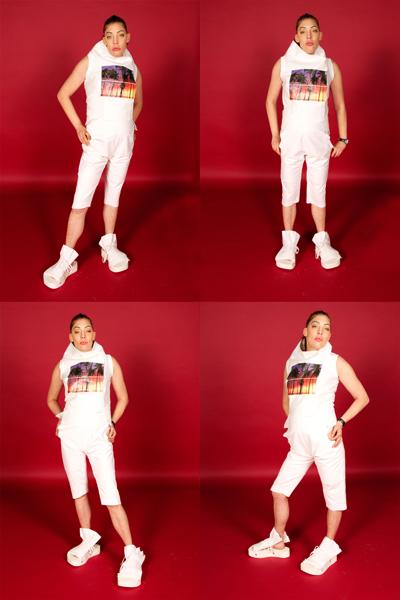Kim en Paul's Trip
I first stumbled on a selection of Dutch photographer, Jan Hoek's, work at Foam's Unseen Photo Festival earlier this year and remembered his insane zine about a semi-nomadic group of people living in Kenya and Northern Tanzania called, New Ways of Photographing the New Masai. The amateur models and relationships he built up with his subjects intrigued me and I wanted to hear more about his approach when beginning a new series. He recently finished a project called Kim en Paul's Trip, a continuation of his relationship with one of his subjects, Kim, a former heroin addict based in Amsterdam with modeling aspirations. He took her and her partner Paul away on a trip, thinking their dream vacation could be his dream photo-shoot. He made a Kim-mobile which he described as "like a Bat-mobile, but [with pictures of] Kim's face on it," and took them to a beach in Belgium. The photos were as raw and bizarre as that brief explanation would suggest. Despite being incredibly untraditional, Hoek recently scored a major grant, so I decided to Skype him and chat about his upcoming work.
Advertisement
VICE: When we spoke on the phone you mentioned some people have outright said your images are "bad". Do you think it's the digital, raw, aspect to them?
Jan Hoek: Well they don't say the photos are bad, but they say the photos are ugly. They think I do it intentionally, but to be honest I just try to make the photos beautiful the way I see them. My ideals don't match all the photography world rules: I don't like perfect light, I don't like cleanliness, and I don't like perfect symmetry. I think my beauty standards are similar to Russian wedding photography or from African kitschy photo studios. Those are the influences I try and incorporate in my own work.
Jan Hoek: Well they don't say the photos are bad, but they say the photos are ugly. They think I do it intentionally, but to be honest I just try to make the photos beautiful the way I see them. My ideals don't match all the photography world rules: I don't like perfect light, I don't like cleanliness, and I don't like perfect symmetry. I think my beauty standards are similar to Russian wedding photography or from African kitschy photo studios. Those are the influences I try and incorporate in my own work.
A photo from Hoek's "Pattaya Sex Bubble" series
You often choose to photograph people on the fringes of society, what interests you about these types of subjects?
Well I never explicitly choose for models to be on the fringes of society, I just look for people who I think are the coolest and they always happen to be a bit raw. I think it also has something to do with myself being a control freak. I find it difficult to let things go and feel awkward a lot of times. It feels liberating to hang with people who don't care.I know you've been asked if you think what you're doing is exploitative, but I think a majority of your work is actually collaborative—would you agree?
Yeah, I do like to raise questions about how photography can be exploitative and will always have an exploitative side, but I only raise those questions because I think it's important not to cross the line. A lot of times the photograph is a result from a collaboration, and sometimes it can be a compromise in which me and the model find a middle ground. Although I do understand it, I think it's strange the people that raise questions about exploitation, immediately direct them at me. Especially because the models really have a voice in my work. People say: no, people from Africa, or poor people, or people who like to get drunk, cannot choose for themselves and you need to protect them for their own choices. I think that is extremely disparaging.
Well I never explicitly choose for models to be on the fringes of society, I just look for people who I think are the coolest and they always happen to be a bit raw. I think it also has something to do with myself being a control freak. I find it difficult to let things go and feel awkward a lot of times. It feels liberating to hang with people who don't care.I know you've been asked if you think what you're doing is exploitative, but I think a majority of your work is actually collaborative—would you agree?
Yeah, I do like to raise questions about how photography can be exploitative and will always have an exploitative side, but I only raise those questions because I think it's important not to cross the line. A lot of times the photograph is a result from a collaboration, and sometimes it can be a compromise in which me and the model find a middle ground. Although I do understand it, I think it's strange the people that raise questions about exploitation, immediately direct them at me. Especially because the models really have a voice in my work. People say: no, people from Africa, or poor people, or people who like to get drunk, cannot choose for themselves and you need to protect them for their own choices. I think that is extremely disparaging.
Advertisement
In your Pattaya Sex Bubble series you blend the type of photography & advertising surrounding sex tourism and adapt it to create referential work—what do you like about the existing material you're appropriating?
Because it is all so beautiful! And of course when you make work about Pattaya where everything is neon-colored with pink, gold and glitters, you should not try to make a sophisticated photo book from it.
Because it is all so beautiful! And of course when you make work about Pattaya where everything is neon-colored with pink, gold and glitters, you should not try to make a sophisticated photo book from it.
"Pattaya Sex Bubble"
With "Kim en Paul," do you ever feel any responsibility while you're spending time shooting them? Or is a clear photographer/subject relationship established even when you're on holiday with them?
Well yeah, all the time. They also became friends from me. I've known them for six years now. A lot of models, you shoot and go, but when you know people for so long you get attached. And I have to be concerned, if I'm not concerned it's impossible to get along with them and then it's impossible to go to a five star hotel with them without being kicked out. Although, we still were kicked out of the hotel, but only ten minutes before we checked out, so I thought 'OK, no problem, I'll put the tip I had for the hotel in my pocket again and we'll leave!' Kim and Paul got 1200 euros payment for the holiday and they really wanted to tattoo each other names on their body, but they didn't know how fast 1200 euro can be spent, so before they knew it, they had no money anymore for a tattoo. Then I manage to find a friend, the artist Mick Johan who wanted to tattoo them for free.
Well yeah, all the time. They also became friends from me. I've known them for six years now. A lot of models, you shoot and go, but when you know people for so long you get attached. And I have to be concerned, if I'm not concerned it's impossible to get along with them and then it's impossible to go to a five star hotel with them without being kicked out. Although, we still were kicked out of the hotel, but only ten minutes before we checked out, so I thought 'OK, no problem, I'll put the tip I had for the hotel in my pocket again and we'll leave!' Kim and Paul got 1200 euros payment for the holiday and they really wanted to tattoo each other names on their body, but they didn't know how fast 1200 euro can be spent, so before they knew it, they had no money anymore for a tattoo. Then I manage to find a friend, the artist Mick Johan who wanted to tattoo them for free.
Advertisement
Side note, did you have a blast with them?
Yes, I love to be with them. You can only work with them if you can manage not to serious all the time. When we had car trouble, the Kim-mobile was broken down next to the highway and they didn't believe we would ever reach the hotel. I tried to cheer them up by showing my ass to passing tour busses. Something like that always cheers them up and myself as well. Kim and Paul can be extremely difficult, but it quickly melts when you get to know their sweet side. Their initial approach to everybody is so open and friendly. They only get mad when they feel people aren't treating them properly, taking advantage. That happens a lot.
Yes, I love to be with them. You can only work with them if you can manage not to serious all the time. When we had car trouble, the Kim-mobile was broken down next to the highway and they didn't believe we would ever reach the hotel. I tried to cheer them up by showing my ass to passing tour busses. Something like that always cheers them up and myself as well. Kim and Paul can be extremely difficult, but it quickly melts when you get to know their sweet side. Their initial approach to everybody is so open and friendly. They only get mad when they feel people aren't treating them properly, taking advantage. That happens a lot.
You recently won the prestigious Charlotte Kohler Prize, what do you hope to continue making with this?
My next project I want to do is with Fashion designer Duran Lantink where we will collaborate with a trans sex worker organization in Cape Town. But I also want to work in a country where there is war and figure out with people living in the war area how they still like to be photographed and what a photograph can mean for them.Are you looking at other photographer's work, if so who are you into these days?
Well my mentor in the Netherlands is Paul Kooiker, he is the only photography teacher I've ever had and taught me that to take a good photo, you need good ideas more than a good camera. Internationally Boris Mikhaloiv is my big hero, but if I go for the younger generation, then I like artists like Augustin Rebetez because he makes the most crazy, dark work that you can imagine. I am also really inspired by some Tumblr-artists who are just 19 year old kids and don't necessarily have a name in the "real" photography world, like http://psyberbully.com.
My next project I want to do is with Fashion designer Duran Lantink where we will collaborate with a trans sex worker organization in Cape Town. But I also want to work in a country where there is war and figure out with people living in the war area how they still like to be photographed and what a photograph can mean for them.Are you looking at other photographer's work, if so who are you into these days?
Well my mentor in the Netherlands is Paul Kooiker, he is the only photography teacher I've ever had and taught me that to take a good photo, you need good ideas more than a good camera. Internationally Boris Mikhaloiv is my big hero, but if I go for the younger generation, then I like artists like Augustin Rebetez because he makes the most crazy, dark work that you can imagine. I am also really inspired by some Tumblr-artists who are just 19 year old kids and don't necessarily have a name in the "real" photography world, like http://psyberbully.com.
Advertisement

